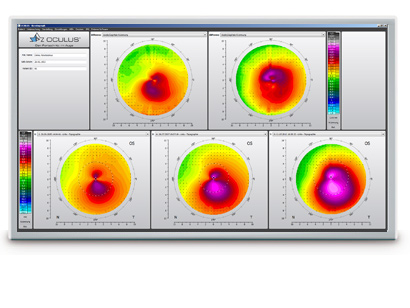Small and Almighty!
The Easygraph offers the ideal solution to practices struggling with limited space. Mounting directly on the slit lamp, this space-saving corneal topographer incorporates assessment of the cornea directly into the examination process. The Easygraph uses the same precise measuring technology as the keratograph and is both a topographer and a keratometer combined into one unit. Numerous analysis and display formats support you in the quantitative classification of the cornea. The integrated contact lens fitting module and the optionally available, supplementary software, such as OxiMap, assist you in your competent contact lens consultations and creating confidence and trust.
Request A Quote | Request A Free Demo
 The Easygraph – The Small Performance Wonder
The Easygraph – The Small Performance Wonder
The Easygraph works with the tried and tested measuring and device technology that has become indispensable in today’s contact lens fitting and reliable diagnostics fields. Ideal where space is limited.

Contact Lens Fitting and Fluorescein Image Simulation
A list of recommended contact lenses available from well-known manufacturers is generated based on your patient’s corneal topography data. Prior to fitting, fluorescein images can be simulated and adjusted (rotate, offset, change parameters).
 OxiMap® – Visualization of the Oxygen Transmissibility of Soft Contact Lenses
OxiMap® – Visualization of the Oxygen Transmissibility of Soft Contact Lenses
Easy to understand OxiMap® presents a color map of the oxygen transmissibility of soft contact lenses based on the lens power, which is easy to understand – even for your customers!
Compact Corneal Topographer
The Easygraph combines small construction with grand technology. The tried and tested measuring system is identical to that of the keratograph. This compact topographer is a combination of a topography system and an integrated keratometer. In the non-contact examination process, 22,000 measuring points are used to map the cornea. Digital image transmission and automatic release guarantee the best possible reproducibility.

Simple Mounting on the Slit Lamp.
The Easygraph comes complete with a slit lamp adapter and optional guide rail. These make it easy to move the Easygraph from the work position to the idle position. After using the Easygraph, you can resume the examination with the slit lamp as normal.
Easy-to-Understand Presentation
Precise measurement is the basis for many types of analysis. Graphic presentation of the data supports you in the evaluation and quantitative assessment of the corneal topography:
- Overview with camera image and color map
- 3D and 2D display
- Various color maps
- Plot of the Fourier analysis
- Refractive map
- Height map of the topography data
- Map of the sagittal and tangential radii
- Comparison of different examination results for follow-up purposes

Progression Follow-up Diagnostics
Regular progression follow-ups are essential, not only for cases of keratoconus. In the “Compare examination“ display, up to four examinations can be directly compared with each other and any changes of the corneal topography can be displayed with color-coding.
 Display of Refractive Corneal Changes
Display of Refractive Corneal Changes
Changes in the refractive power of the cornea as a resulting of wearing of Ortho-K contact lenses or of refractive surgery can be analyzed and documented.

Keratoconus Detection at the Highest Level
Thanks to topography measurement, corneal abnormalities can often be detected and diagnosed in the early stages. The measurements are compared with those in a norm database. If abnormalities are present, the measured values are displayed in yellow or red. If a keratoconus is present, it is classified based on the existing topography. The indices map also helps you in progression follow-ups and where applicable, shows you whether and how the keratoconus has changed.

Zernike-Analysis
Corneal abnormalities can be displayed in 2D and 3D using the Zernike Analysis. The displayed aberration coefficient provides information about the optical image quality of the cornea. In addition to this corneal wavefront analysis, the software also marks the location of the apex and is easy for the user to recognize.

| Measuring range | 3–38 mm, 9–99 dpt |
| Accuracy | ± 0.2 dpt |
| Reproducibility | ± 0.2 dpt |
| Number of rings | 22 |
| Working distance | 40 mm |
| Number of test points | 22,000 |
| Dimensions: H x W x L | 214 x 103 x 116 mm |
| Weight | 630 g |
| Power supply unit | Input: 100-240 V Output: 5 V / 1 A |
| PC Minimum requirements | Processor: Intel Core i3 or better, 4GB RAM, Hard drive space: min. 500 GB, Graphic card: Intel HD Graphics 2000 or better, recommended screen resolution: 1920 x 1080 (Full-HD) |


